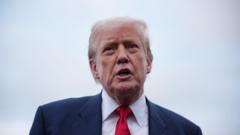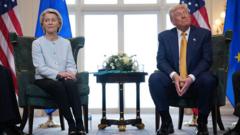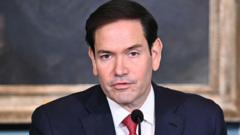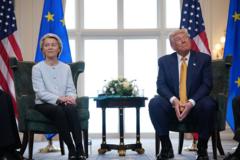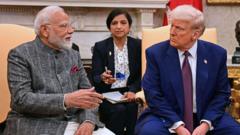While President Trump promotes his tariffs as victories that will boost American manufacturing and investment, the reality is fraught with uncertainty regarding their global impact and economic repercussions at home.
The Costly Gamble of Trump's Tariffs: Assessing the Trade Landscape

The Costly Gamble of Trump's Tariffs: Assessing the Trade Landscape
President Trump's recent tariff impositions are reshaping global trade dynamics and raising questions about their long-term viability.
In April, President Donald Trump surprised the world with sweeping new import tariffs, which he later halted due to ensuing financial turmoil. Four months later, he emphasizes perceived successes through new agreements and unilateral tariffs that have thus far avoided severe disruptions in the financial markets. Yet, the long-term implications of his actions remain critical.
Trump claims these tariffs will result in increased revenue, revitalized domestic manufacturing, and significant foreign investment. However, it is unclear whether these anticipated benefits will materialize or produce adverse consequences. The global trade landscape is shifting towards a more protectionist stance, but despite this transformation, immediate fallout has been limited, suggesting that a delay may exist before full effects are felt.
Among the hastily drawn deadlines was a directive for countries to finalize their trade terms with the U.S. by August 1, leading to approximately a dozen agreements, some lacking in detail. Initial tariff impositions varied, with the UK receiving a relatively lower 10% rate, while other nations with higher deficits faced steeper tariffs. Countries that failed to commit to increased American imports often experienced punitive rates.
While alarming forecasts of economic fallout and recession risks did not fully materialize, tariff negotiations have introduced a level of certainty; businesses can now better strategize pricing and planning. However, this higher average tariff rate compared to earlier this year indicates deeper institutional changes.
The implications of this tariff policy vary by nation: while India may experience limited impact as U.S. demand makes up a small fraction of its GDP, Germany faces a more acute risk of growth loss due to its automotive industry's reliance on exports. India rose to become a leading source of smartphones in the U.S. amid fears of China's trade situation, yet it must be watchful of other nations that could undercut its position.
Domestically, the tariffs have increased U.S. revenue significantly, which was an explicit aim of Trump's policies, yet they are not without consequences for American consumers. Prices for consumer goods may soon rise, potentially jeopardizing Trump's promises to lower consumer costs, creating a contentious political landscape leading to upcoming elections.
Ongoing negotiations with prominent partners like Canada and Taiwan remain unresolved. Some trade agreements have been informal, while others include provisions that foreign leaders dispute existing. The specifics of these arrangements could significantly influence outcomes, with analysts stressing the importance of detailed terms.
In conclusion, the world has edged away from the brink of a trade war, but the reality of these tariffs may lead to a realignment in global economic relations, with repercussions felt far beyond the immediate future. Such changes could reshape America's role in global trade, challenging the predictably favorable economic relationships it has enjoyed historically. As the U.S. faces pressures on growth and consumer welfare, the broader journey of these tariffs will play out over years rather than fleeting months.


